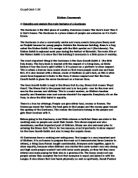Describe in detail the wedding ceremonies in Christianity and Sikhism and carefully explain the key features of each.
Describe in detail the wedding ceremonies in Christianity and Sikhism and carefully explain the key features of each.
The Sikh wedding ceremony is the ‘Anand Karaj’ meaning the ‘ceremony of bliss’. It takes place in the Gurdwara. First a meeting takes place called the Milni. It involves all relatives exchanging gifts and turbans. A reception meal is then eaten. After, the wedding ceremony takes place infront of the guru Granth Sahib. The Groom comes forward and sits facing the holy book. The bride comes in and sits at his left-hand side. The Granthi explains all the responsibilities. The couple then bow to the holy book to show they accept them. The couple stands with their fathers and a lesson is read and a hymn sung. The bride’s father places garlands of flowers over the couple. He takes the grooms scarf and ties it to the bride’s dupatta. On behalf of the wife, the ragis then recite a shabad. The Granthi then recites the first verse of the Lavan, composed by Guru Ram Das. This verse emphasises the performance of duty to the family and the community. Then the other three verses are sung. The second verse refers to the stage of yearning and love for each other. The third verse refers to the stage of detachment and the fourth verse refers to the final stage of harmony and union in married life during which human love blends into the love or God. For each verse, the couple walks slowly in a clockwise direction around the holy book, the groom leading the bride. After each verse they bow. On the final round, they may be showered with flowers. The ceremony concludes with more singing, the Anand, the Ardas prayer and the sharing of Karah Parshad. The new wedded couple then sits to receive gifts of money from the congregation. A meal is then shared in the Langar, and a reception may also have been booked. The couple may then go to their house or to their honeymoon.







